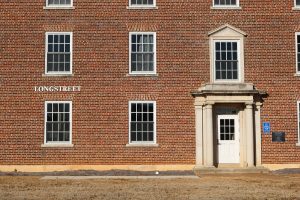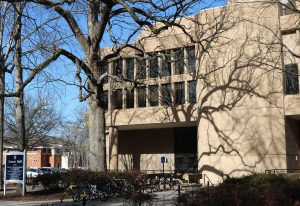After several years of contextualization efforts, the university will unveil new plaques at six locations in an attempt to recognize what many community members see as troublesome reminders of history embedded in several structures on the Oxford campus.
The plaques will be revealed during a ceremony on campus March 2.
The contextualization plaques will be placed at Barnard Observatory, Lamar Hall, Longstreet Hall, George Hall, in addition to a plaque recognizing the university’s enslaved laborers in the constructions of Barnard Observatory, Croft, the Lyceum and Hilgard Cut.

The University announced that they would place contextualization plaques around campus. The plaques are set to be unveiled on March 2nd. Photo by Logan Connor
Chancellor Vitter also accepted an additional recommendation to add a contextualization plaque for the stained glass Tiffany windows in Ventress Hall. The windows recognize the University Greys, a group of Ole Miss students who left the university in 1861 to serve in the Civil War. This plaque will also be included in the March event.
The locations and text for the plaques were decided on by the Chancellor’s Advisory Committee for History and Context, a group created in April 2016 to recognize sites for contextualization and create content for the plaques.
A separate Contextualization Ceremony Committee had its first official meeting Wednesday to discuss the best way to acknowledge the placement of the plaques on campus.
The committee is chaired by Katrina Caldwell, vice chancellor for Diversity and Community Engagement, and Alice Clark, interim vice chancellor for University Relations. Other committee members include faculty members Donald Cole, Jennifer Ford, Jeff Jackson, Amy Lewis, John Neff, Ethel Young-Scurlock and Deetra Wiley, as well as ASB President Dion Kevin.
Kevin, the lone student on the committee, said he is excited about how quickly the university is moving along with the plaque ceremony.
“As the flagship institution of Mississippi, this is an exciting opportunity for Ole Miss to engage the local community and show others our commitment to moving forward while maintaining our identity,” Kevin said. “I hope these efforts to contextualize our campus are unrelenting and prove to be models for our peer institutions across the country.”

Lamar Hall. Photo by Logan Conner
Previews of the plaques can be viewed online.
One of the contextualization plaques, titled “The University’s Enslaved Laborers,” will be located near Croft and reads, “The first buildings on this historic circle were constructed using the labor of enslaved African Americans. From July 1846 to the opening of the University on November 6, 1848, local slaveholders received payments to rent their slaves to the college in order to clear land, create roads, dig wells, and build the original campus structures.”
The last sentence on this piece of recognition will read, “The University of Mississippi today honors the legacy of these enslaved individuals and acknowledges the injustices under which they lived and labored.”
John Neff, director for Civil War research at Ole Miss and member of the contextualization committee, said he is proud of the work they are doing.
“Everyone on the committee worked hard to produce an excellent plan,” Neff said. “The chancellor is showing real leadership by seeing the work we proposed be accomplished. These efforts to understand and embrace our complicated past are important steps in making the university open and welcoming to all.”
With the ceremony just more than a month away, the committee says it is still in the planning stages. The Daily Mississippian reached out to members of the committee, who said more details regarding the ceremony will be available next week.






